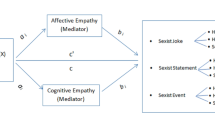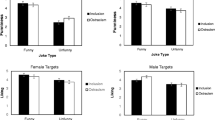Abstract
Spontaneous vs. more controlled indicators of sexist attitudes were assessed in a laboratory experiment with 131 male German undergraduates. Participants rated the funniness of sexist and nonsexist jokes either with or without time pressure, and completed self-report measures of sexism and related constructs. With time pressure, participants showed greater liking for sexist jokes than without. No such effect was found for nonsexist jokes. Both with and without time pressure, sexist joke ratings showed meaningful correlations with standard self-report measures, which attests to the joke measure’s high reliability and construct validity. Directions for future research are discussed.


Similar content being viewed by others
References
Athenstaedt, U. (2002). Normative Geschlechtsrollenorientierung: Entwicklung und Validierung eines Fragebogens [Normative Gender Role Attitudes: The development and validation of a new questionnaire]. Zeitschrift für Differentielle und Diagnostische Psychologie, 21, 91–104.
Banse, R., & Gawronski, B. (2003). Die Skala Motivation zu vorurteilsfreiem Verhalten: Psychometrische Eigenschaften und Validität [The scale Motivation to Act Without Prejudice: Psychometric properties and validity]. Diagnostica, 49, 1–13.
Baumeister, R. F., Heatherton, T. F., & Tice, D. M. (1994). Losing control: How and why people fail at self-regulation. San Diego, CA: Academic Press.
Bohner, G., Jarvis, C. I., Eyssel, F., & Siebler, F. (2005). The causal impact of rape myth acceptance on men’s rape proclivity: Comparing sexually coercive and noncoercive men. European Journal of Social Psychology, 35, 819–828.
Burt, M. R. (1980). Cultural myths and supports for rape. Journal of Personality and Social Psychology, 38, 217–230.
Crowne, D. P., & Marlowe, D. (1960). A new scale of social desirability independent of psychopathology. Journal of Consulting Psychology, 24, 349–354.
Dunton, B. C., & Fazio, R. H. (1997). An individual difference measure of motivation to control prejudiced reactions. Personality and Social Psychology Bulletin, 23, 316–326.
Eckes, T., & Six-Materna, I. (1998). Leugnung von Diskriminierung: Eine Skala zur Erfassung des modernen Sexismus [Denial of discrimination: A scale measuring modern sexism]. Zeitschrift für Sozialpsychologie, 29, 224–238.
Eckes, T., & Six-Materna, I. (1999). Hostilität und Benevolenz: Eine Skala zur Messung des ambivalenten Sexismus [Hostility and benevolence: A scale measuring ambivalent sexism]. Zeitschrift für Sozialpsychologie, 30, 211–228.
Eyssel, F., & Bohner, G. (2006). Impliziter ambivalenter Sexismus: Erste Ergebnisse zur Entwicklung eines reaktionszeitbasierten Forschungsinstruments [Implicit ambivalent sexism: First results on the development of a reaction-time based research instrument]. In H. Hecht, S. Berti, G. Meinhardt, & M. Gamer (Eds.), Beiträge zur 48. Tagung experimentell arbeitender Psychologen. Lengerich: Pabst Science Publishers.
Eyssel, F., Bohner, G., & Siebler, F. (2006). Perceived rape myth acceptance of others predicts rape proclivity: Social norm or judgmental anchoring? Swiss Journal of Psychology, 65, 93–99.
Fazio, R. H., & Olson, M. A. (2003). Implicit measures in social cognition research: Their meaning and use. Annual Review of Psychology, 54, 297–327.
Fazio, R. H., & Towles-Schwen, T. (1999). The MODE model of attitude–behavior processes. In S. Chaiken & Y. Trope (Eds.), Dual process theories in social psychology. New York: Guilford.
Ford, T. E., & Ferguson, M. A. (2004). Social consequences of disparagement humor: A prejudiced norm theory. Personality and Social Psychology Review, 8, 79–94.
Ford, T. E., Wentzel, E. R., & Lorion, J. (2001). Effects of exposure to sexist humor on perceptions of normative tolerance of sexism. European Journal of Social Psychology, 31, 677–691.
Friese, M., Hoffmann, W., & Wänke, M. (2007, in press). When impulses take over: Moderated predictive validity of explicit and implicit attitude measures in predicting food choice and consumption behavior. British Journal of Social Psychology.
Gerger, H., Kley, H., Bohner, G., & Siebler, F. (2007). The Acceptance of Modern Myths About Sexual Aggression (AMMSA) Scale: Development and validation in German and English. Aggressive Behavior, 33, 420–440.
Gilbert, D. T., & Hixon, J. G. (1991). The trouble of thinking: Activation and application of stereotypic beliefs. Journal of Experimental Social Psychology, 26, 199–216.
Glick, P., & Fiske, S. T. (1996). The ambivalent sexism inventory: Differentiating hostile and benevolent sexism. Journal of Personality and Social Psychology, 70, 491–512.
Glick, P., Fiske, S. T., Mladinic, A., Saiz, J. L., Abrams, D., Masser, B., et al. (2000). Beyond prejudice as simple antipathy: Hostile and benevolent sexism across cultures. Journal of Personality and Social Psychology, 79, 763–775.
Greenwood, D., & Isbell, L. M. (2002). Ambivalent sexism and the dumb blonde: Men’ s and women’s reactions to sexist jokes. Psychology of Women Quarterly, 26, 341–350.
Henkin, B., & Fish, J. M. (1986). Gender and personality differences in the appreciation of cartoon humor. Journal of Psychology, 120, 157–175.
Hofmann, W., Rauch, W., & Gawronski, B. (2007). And deplete us not into temptation: Automatic attitudes, dietary restraint, and self-regulatory resources as determinants of eating behavior. Journal of Experimental Social Psychology, 43, 497–504.
Klonis, S. C., Ashby Plant, E., & Devine, P. G. (2005). Internal and external motivation to respond without sexism. Personality and Social Psychology Bulletin, 31, 1237–1249.
Musch, J., Brockhaus, R., & Bröder, A. (2002). Ein Inventar zur Erfassung von zwei Faktoren sozialer Erwünschtheit [An inventory for the assessment of two factors of social desirability]. Diagnostica, 48, 121–129.
Paulhus, D. L. (1998). Manual for the balanced inventory of desirable responding. Toronto, Canada: Multi-Health Systems.
Payne, D. L., Lonsway, K. A., & Fitzgerald, L. F. (1999). Rape myth acceptance: Exploration of its structure and its measurement using the Illinois Rape Myth Acceptance Scale. Journal of Research in Personality, 33, 27–68.
Ryan, K. M., & Kanjorski, J. (1998). The enjoyment of sexist humor, rape attitudes and relationship aggression in college students. Sex Roles, 38, 743–756.
Sabelus, S. (2004). Sexual harassment: Feminist attitude and physical attractiveness as risk factors. Unpublished Diploma Thesis, University of Bielefeld, Germany.
Sev’er, A., & Ungar, S. (1997). No laughing matter: Boundaries of gender-based humour in the classroom. Journal of Higher Education, 68, 87–105.
Siebler, F., Sabelus, S., & Bohner, G. (2007, in press). A refined computer harassment paradigm: Validation, and test of hypotheses about target characteristics. Psychology of Women Quarterly.
Strack, F., & Deutsch, R. (2004). Reflective and impulsive determinants of social behavior. Personality and Social Psychology Review, 8, 220–247.
Stöber, J. (1999). Die Soziale-Erwünschtheits-Skala-17 (SES-17). Entwicklung und erste Befunde zu Reliabilität und Validität [The Social Desirability Scale-17 (SDS-17): Development and first results on reliability and validity]. Diagnostica, 45, 173–177.
Swim, J. K., Aikin, K. J., Hall, W. S., & Hunter, B. A. (1995). Sexism and racism: Old-fashioned and modern prejudices. Journal of Personality and Social Psychology, 68, 199–214.
Thomas, C. A., & Esses, V. M. (2004). Individual differences in reactions to sexist humor. Group Processes and Intergroup Relations, 7, 89–100.
Wilson, T. D., Lindsey, S., & Schooler, T. Y. (2000). A model of dual attitudes. Psychological Review, 107, 101–126.
Zillmann, D., & Cantor, J. R. (1976). A disposition theory of humor and mirth. In A. J. Chapman & H. C. Foot (Eds.), Humor and laughter: Theory, research and applications. New York: Wiley.
Acknowledgments
This research and the preparation of this manuscript was supported by a grant from the Deutsche Forschungsgemeinschaft (BO 1248/4-3) to Gerd Bohner and Frank Siebler.
We thank Paul Schreiber and Philipp Süssenbach for their help in conducting this study.
Author information
Authors and Affiliations
Corresponding author
Rights and permissions
About this article
Cite this article
Eyssel, F., Bohner, G. The Rating of Sexist Humor Under Time Pressure as an Indicator of Spontaneous Sexist Attitudes. Sex Roles 57, 651–660 (2007). https://doi.org/10.1007/s11199-007-9302-5
Received:
Accepted:
Published:
Issue Date:
DOI: https://doi.org/10.1007/s11199-007-9302-5




